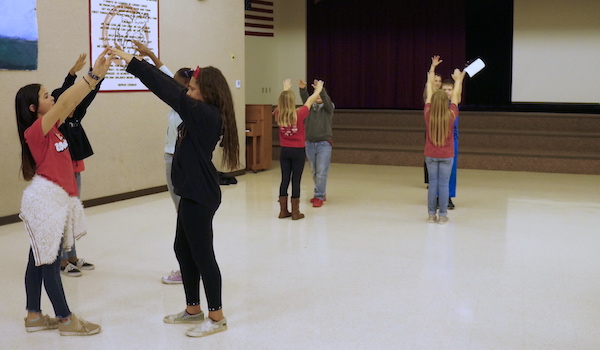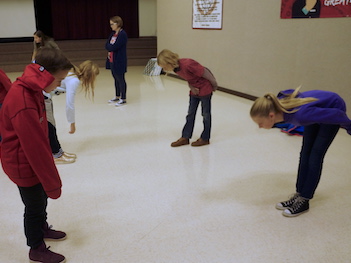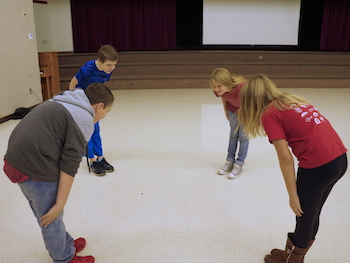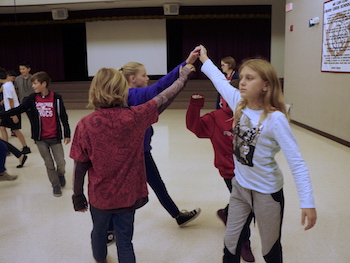SUBJECTS
GRADE
Show Results
1600s Dancing and Instruments

Lesson Summary
- Dance an English dance to “Scarborough Fair” and “Greensleeves.”
- Experience Renaissance/Baroque-style instruments.
Lesson Plan and Procedure
Lesson Key Facts
- Grade(s): 6
- Subject(s): Dance, Music, Social Studies
- Duration of lesson: 45-60 minutes
- Author(s): Emily Soderborg
Note: This is one of several lessons in a unit focused around the song “Scarborough Fair.” The lesson introduces various aspects of the Renaissance period. A PowerPoint presentation found in the materials and equipment section can be used to help facilitate the unit.
Teacher background: The beginning of the Renaissance was self-defined, but the previous period, the Middle Ages, was defined by the originators of the Renaissance. Like the Middle Ages, the Baroque period (which followed the Renaissance) wasn’t defined until much later, in the late nineteenth and early twentieth centuries. This European cultural shift from Renaissance to Baroque happened gradually; therefore, precise and definitive dates are impossible. Nominally, however, 1600 to 1750 marks the development of an audibly different range of musical styles, called the Baroque period. However, the broadside ballads and other music of the common people remained very similar in the Baroque time period as in the Renaissance.
The invention of the printing press and the spread of literacy profoundly affected music-making. Musicians in households were now able to write down music, use the new printed songbooks of composers, and sing from broadside ballad sheets sold in the street. The spread of printing and literacy affects our own knowledge of the period, because there are more surviving instructions for dances and more printed music from the time. (For more information about this, click here.)
The Dancing Master
Teacher: Can you think of any other reasons people during the 1600s wanted to hear “Scarborough Fair” besides to tell a story? What do you think were some purposes for music in general? Can you think of any other purposes for this song in particular? What are some things that you do for fun today? What are some things you think people in the 1600s did for entertainment?
Teacher: The people in the 1600s didn’t have TV or video games. A lot of them were starting to learn how to read because the printing press was still a fairly new invention. So what did they do to occupy their time? They danced!
Teacher: We know this because in England there was a man named John Playford (1623–1687) who published a book series called The Dancing Master. The first edition in 1651 sold out quickly, so a second edition with nine additional dances was published the next year, even though public dancing was forbidden by the Puritan law up until 1660. (For more information about why it was forbidden, see the section “Additional Resources.”)

Teacher: New editions were continually printed for over 75 years, until the last edition was printed in 1728. The Dancing Master outlived John Playford and even his son, Henry, who continued the work until he neared his own death. From 1706 to 1728, the work was continued by John Young. The first edition contained 105 dances with single-line melodies. Each later edition introduced new songs and dances and dropped others, depending on what was popular. Can you think of a dance that is popular right now? Do you think that dance will still be popular in a couple of years?
Teacher: One of the most interesting things about this series of books is that so many of its tunes had been popular since the Renaissance. John Playford wrote in his collection that they were “great tunes which had stood the test of time, many of which remain popular to this day among lovers of traditional music.” The additional tunes, which increased with each printing, were a mixture of the melodies of new songs in the theatre and the latest popular broadside ballad tunes. John Playford’s The Dancing Master is one of the earliest surviving collections, but there are references to "country dances" or even "English country dances" as early as 1551, and Queen Elizabeth (who died in 1603) was repeatedly said to have encouraged and danced country dances. So these dances could have been done much earlier than we know. (For more information about John Playford and The Dancing Master, click here or here.)
Learning the Dance
Teacher: Let’s see what some of these popular dances looked like. Watch closely, because we are going to do the dance ourselves.
Have students watch the video of the “Scarborough Fair” dance several times, asking them to share what they noticed, such as the steps and movement of the dancers.
Break students up into groups of four (two sets of partners), and review dance terminology with students through movement:
Bow to your corner (the person beside you)

Bow to your partner (the person across from you)

Right hand star—all walk in a circle with right arms in the center (clockwise)

Left hand star—all walk in a circle with left arms in the center (counter-clockwise)

Right shoulder cross—switch places with your partner by walking past them on your right shoulder

Teacher: Now it’s time for us to do the actual dance!
Bow or curtsey toward center of circle
Face corners: Take one step towards your corner, raising arms to make an arch
Take one step back, lowering arms
Take one step towards your corner, raising arms to make an arch
Take one step back, lowering arms
Right-hand star: Walk for eight counts in clockwise direction
Left-hand star: Walk for eight counts in counter-clockwise direction
Face partners: Head couple does a right shoulder cross
Next couple does a right shoulder cross
Head couple does a right shoulder cross
Next couple does a right shoulder cross
Repeat until the end of the song, then finish with a bow or curtsey

Teacher: “Scarborough Fair” is a song that they might have danced to, but just as words change in different variants over time, the dances also changed songs and steps, depending on what songs were known at the time and how the dances were learned or taught. The song listed in Playford’s collection with part of this dance was titled “Greensleeves and Pudding Pies” from 1686 to 1716 and then was titled “Greensleeves and Yellow Lace” from 1721 to 1728. Some of you might recognize this melody as a different song.
Watch the YouTube version of “Greensleeves.”
Teacher: Did anyone recognize the song? How is the dance the same? How is it different? Let’s figure out how to dance the “Greensleeves” version.
Allow students time to figure out the differences.
Dance extension: Allow students to create their own Renaissance-style dance(s), drawing from the movements they learned today, but in new combinations and patterns.
Instruments
Teacher: What instruments did you hear accompanying this version of the dance? (Recorder, tambourine, lute, or guitar)
Teacher: All of these instruments were used in Renaissance and Baroque music. Many instruments originated during the Renaissance; others were variations of, or improvements upon, instruments that had existed previously in the Middle Ages. At the beginning of the sixteenth century, instruments were considered to be less important than voices, so they were used for dances and for accompanying vocal music.
Teacher: The recorder was first used as an instrument in Europe during the Middle Ages and continued as a popular choice for composers and musicians in the Renaissance and Baroque periods, but it stopped being used in the Classical and Romantic periods. However, it was revived in the twentieth century when people started trying to play music in historically accurate ways. Listen to what “Scarborough Fair” sounds like played on a recorder.
Play “Scarborough Fair” on the recorder while students listen, or have students listen to a duet of a recorder and Flemish harpsichord or a recorder consort (a group of recorders of different sizes playing together is called a consort).

Recorder extension: If you have recorders in your school, this would be a great introduction to learning how to play them. Recorders are a hands-on connection to the Renaissance and Baroque periods. “Scarborough Fair” would be a good piece to work towards learning, but it is not a beginning recorder piece. In addition to the Scarborough Fair sheet music, here is a website that shows the fingerings for “Scarborough Fair."
Learning Objectives
- Understand the transformation of cultures during the Renaissance and Baroque periods and the impact of this transformation on modern times.
- Learn a historical dance from the 1600s.
- Relate music with societal, cultural, and historical context to deepen understanding.
Utah State Board of Education Standards
This lesson can be used to meet standards in many grades and subject areas. We will highlight one grade’s standards to give an example of application.
Grade 6 Social Studies
Strand 2: Globalization: Students will compare how the transformation and changes of the post-classical era (Ca. 500 C.E.–1500 C.E.) set in motion the expansion of knowledge through science, language, writing, religion, and technological innovations.
Standard 6.2.3: Identify the most historically significant inventions and innovations from Ca. 500 C.E.–1500 C.E. (for example, printing press/moveable type, astronomy, medicine), and argue their ongoing importance.
Grade 6 Dance
Standard 6.D.CO.3: Interpret and show how the movement and qualities of a dance communicate its cultural, historical, and/or community ideas and perspectives of the culture, historical period, or community purpose or meaning.
Grade 6 Music
Standard 6.M.R.5: Identify possible intent of a music selection, and how the music elements are used to convey it.
Standard 6.M.R.6: Explore/express feelings conveyed by a music selection through movement, drawing, or writing.
Standard 6.M.R.7: Identify music elements that are characteristic of different genres of music.
CONNECT (Standards 6.M.CO.1–3): Students will synthesize and relate knowledge from personal and collaborative experience to make and receive art. They will relate artistic ideas and works with societal, cultural, and historical context to deepen understanding.
Equipment and Materials Needed
- PowerPoint with lesson information (optional)
- “Scarborough Fair” dance
- “Greensleeves” dance (This second video is a similar dance, but “Greensleeves” is in medieval-period costume, which is different clothing than the time period we are discussing. It might be good to point this out to students.)
- Instrumental recording of “Scarborough Fair” (guitar) by Joseph Sullinger. Use this recording to go through the entire dance.
- “Scarborough Fair” duet performed by recorder and Flemish harpsichord (optional)
- “Scarborough Fair” performed by a recorder consort (optional)
Additional Resources
- This is one of several lessons that create a unit focused around the song “Scarborough Fair” to introduce various aspects of the Renaissance period. The other lessons in the unit include the following:
- This book contains 10 songs with simple instrumental parts for recorders and Orff instruments, as well as dance instructions for each piece: Rempel, U. & Kunzman, C. (1996). A Renaissance Banquet: music and dance for recorders and Orff Instruments. New York, NY: Schott Music Corporation.
- Renaissance dancing explained:
- Puritan Law in the 1600s (why dancing and other things were banned)
- Here is a similar dance to the ones learned in the lesson, with the dance steps broken down. However, since it is based on Disney princesses, it might not have a great appeal with sixth-graders.
- History of the song “Greensleeves”
- Video of the dance “Greensleeves and Yellow Lace” from John Playford’s The Dancing Master (the steps were changed to this in later editions of the collection)
- Recorder sheet music for “Scarborough Fair”
- “Scarborough Fair” on lute
- Solo recorder playing “Scarborough Fair” (This video is probably better to listen to rather than watch.)
- “Greensleeves” played by a recorder consort
- This Renaissance music was written for 10 different sizes of recorder, one being over nine feet tall—The Royal Wind Music performing “The Earle of Essex Galiard” by John Dowland [1563–1626]
Image References
- Image 1: Brenda Beyal.
- Image 2: https://commons.wikimedia.org/wiki/File:Playford.jpg
- Image 3–8: Brenda Beyal.
- Image 9: https://commons.wikimedia.org/wiki/File:Different_Sizes_of_Recorders.JPG

www.education.byu.edu/arts/lessons
 Download
Download